It may be that the Dandelion you see most often is Taraxacum officinale, the Common Dandelion, however there are more than 230 species of Dandelion in the UK and the differences between them are small and very complex.
It is not possible to identify a Dandelion to species from a single photograph. Many different things have to be taken into account.
The character of the leaves for instance. Some species have alternate lobes and some are opposite and there are some species that don’t have lobes at all, some have a purple central rib and in some it is pale.



 When you understand the leaf you then have to cross reference that with all of the other parts of the flower. The pattern of teeth on the end of each floret for instance.
When you understand the leaf you then have to cross reference that with all of the other parts of the flower. The pattern of teeth on the end of each floret for instance.
 There are so many factors to take into account that identifying a Dandelion to species is a job for the experts. To us it is just a Dandelion, (Taraxacum species).
There are so many factors to take into account that identifying a Dandelion to species is a job for the experts. To us it is just a Dandelion, (Taraxacum species).
So can we even tell that it is a Dandelion?
Yes of course we can. Dandelions belong to the Asteraceae (Daisy) family and they have quite distinctive characteristics.
Like other members of the Asteraceae they have a composite flower head made up of many smaller flowers.
This next picture is of a Common Daisy (Bellis perennis) and shows the arrangement of central disc florets (yellow) and the outer ray florets (white), each “petal” and “disc” is a complete flower in itself and together they make the flower head that we call a Daisy.
 A Dandelion has no disc florets. It is composed solely of ray florets.
A Dandelion has no disc florets. It is composed solely of ray florets.
 This next Dandelion lookalike is quite obviously not a Dandelion because it has central disc florets and it is in fact the flower of Coltsfoot (Tussilago farfara)
This next Dandelion lookalike is quite obviously not a Dandelion because it has central disc florets and it is in fact the flower of Coltsfoot (Tussilago farfara)
 The other easy to spot and important characteristic is that unlike other lookalikes there are no leaves on the flower stem and it is unbranched, each flower head is carried on a single, bare stem. that will rule out the Hawksbits and other pretenders like Cat’s-ears.
The other easy to spot and important characteristic is that unlike other lookalikes there are no leaves on the flower stem and it is unbranched, each flower head is carried on a single, bare stem. that will rule out the Hawksbits and other pretenders like Cat’s-ears.
Dandelion (Single flower head on a bare stem)

Cat’s-ear (Multiple flower heads on a branched stem)
 If you remain unsure then cut it. The Dandelion is the only yellow member of the Asteraceae with a hollow stem and it exudes a milky sap.
If you remain unsure then cut it. The Dandelion is the only yellow member of the Asteraceae with a hollow stem and it exudes a milky sap.
Dandelions secrete latex, not very much in the wild varieties but scientists have developed cultivars for the production of rubber and there are tests being carried out today with tyres made of Dandelion rubber.
At the base of each flower there are a series of down turned bracts. These are sometimes mistaken for sepals but remember that this is a flower head and not an individual flower, each ray floret has it’s own sepals at the base which will eventually become the parachute that will carry the seed.
Each “petal” is a whole flower. It has all that is required to make a flower, a corolla (fused petals) male reproductive parts and female parts too and an ovary that will become a seed.
 So what are all of these pointy bits coming out of the flower? They look like styles but they are covered in pollen, so that would make them stamens, right?
So what are all of these pointy bits coming out of the flower? They look like styles but they are covered in pollen, so that would make them stamens, right?
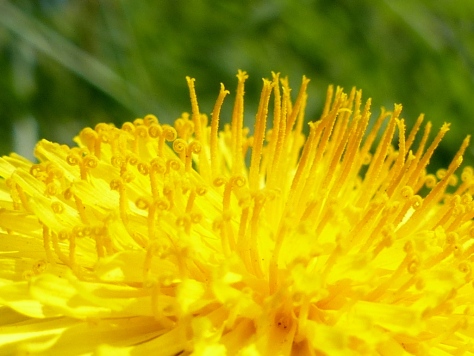 These are the styles, the female part of the flower and they are covered in pollen that they picked up from their own anthers.
These are the styles, the female part of the flower and they are covered in pollen that they picked up from their own anthers.
I have to do a drawing to show you how this works. The anthers develop first and they produce pollen on the inside, The style grows through the middle of the anthers and collects the pollen. The style has two receptive surfaces that are pressed closely together, the pollen collected on the outside does not affect them. So the style carries the pollen.
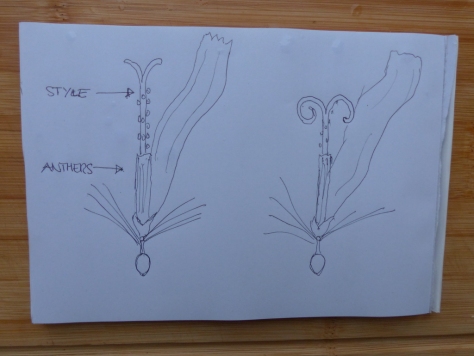 This is the best photograph that I can find to show you the anthers on a Dandelion.
This is the best photograph that I can find to show you the anthers on a Dandelion.
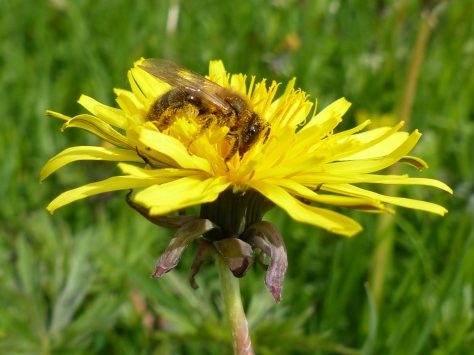 Dandelions produce a lot of pollen.
Dandelions produce a lot of pollen.
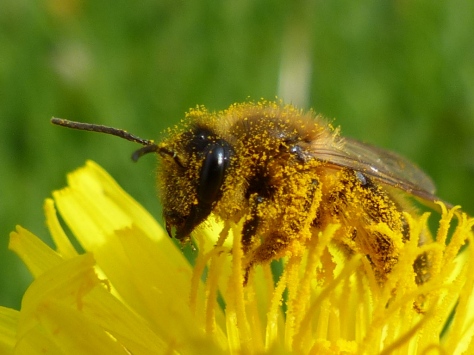 Strangely all of this sexual stuff is not really necessary, most Dandelions are capable of asexual reproduction and their seeds do not require second party fertilisation but it is fun.
Strangely all of this sexual stuff is not really necessary, most Dandelions are capable of asexual reproduction and their seeds do not require second party fertilisation but it is fun.
With 230 plus species in the UK you can pretty well find Dandelions in flower at any time of year, they don’t all flower at the same time, however there is a season.
April is the best time to look for Dandelions, the fields are full of them.
 You will never see a Dandelion with some petals and some seeds, the transformation seems to be instant and total, they close as a flower and when they open again they are a seed head.
You will never see a Dandelion with some petals and some seeds, the transformation seems to be instant and total, they close as a flower and when they open again they are a seed head.
 The seeds are called achenes and the parachute is called a pappus and the parachute is actually made from modified sepals of the tiny flower called a ray floret. Between the seed and the parachute is a stem called a beak. The whole of this structure has grown from the style that both distributed and collected pollen for the flower.
The seeds are called achenes and the parachute is called a pappus and the parachute is actually made from modified sepals of the tiny flower called a ray floret. Between the seed and the parachute is a stem called a beak. The whole of this structure has grown from the style that both distributed and collected pollen for the flower.
 These are the Dandelion clocks of our childhood, you can tell the hour by the number of breaths it takes to disperse the seeds. They are not firmly attached so it is usually early.
These are the Dandelion clocks of our childhood, you can tell the hour by the number of breaths it takes to disperse the seeds. They are not firmly attached so it is usually early.
 The Dandelion weed is without doubt one of our most beautiful wild flowers.
The Dandelion weed is without doubt one of our most beautiful wild flowers.
 I am not really sure why it hasn’t been modified and cultivated for the garden. Dandelions are a very good weed to have in the garden, they have a very deep tap root that draws nutrients up to the surface and makes them available for other, more fancy, flowers. They also attract pollinators.
I am not really sure why it hasn’t been modified and cultivated for the garden. Dandelions are a very good weed to have in the garden, they have a very deep tap root that draws nutrients up to the surface and makes them available for other, more fancy, flowers. They also attract pollinators.
 Dandelions are the food plant for at least twelve species of moth and many other invertebrates. They are rich in nectar as well as pollen and are an important food source for bees.
Dandelions are the food plant for at least twelve species of moth and many other invertebrates. They are rich in nectar as well as pollen and are an important food source for bees.
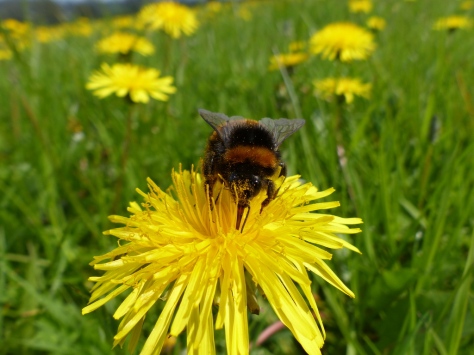 They are also good for us to eat, all parts of the Dandelion are edible.
They are also good for us to eat, all parts of the Dandelion are edible.
 There is something that I should tell you about this beautiful and useful wild flower, it has a wicked side.
There is something that I should tell you about this beautiful and useful wild flower, it has a wicked side.
If you pick a flower and chase your sister with it then she will scream and run away because if you can successfully touch her with the flower then she will be fated to wet the bed. (Dandelions are a lot of fun)
The common French name for a Dandelion is “Pissenlit” and “lit” is the French word for bed. There is some logic in this, Dandelion root has been used in herbal medicine as a diuretic and it does indeed make you piss en lit.
Our own common name Dandelion is derived from another French name “Dent de Lion,” meaning Lion’s tooth and that is a reference to the shape of the leaf.
 The Germans call it Pusteblume (Blow Flower)
The Germans call it Pusteblume (Blow Flower)
 BTW In case you wondered, that lump that you sometimes see in the centre of a new flower is just ray florets that haven’t opened and expanded yet.
BTW In case you wondered, that lump that you sometimes see in the centre of a new flower is just ray florets that haven’t opened and expanded yet.
Kingdom: Plantae
Order: Asterales
Family: Asteraceae
Genus: Taraxacum








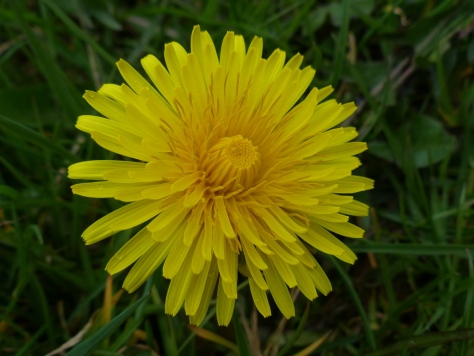



If dandelion is a form of daisy, is it possible that african daisy pollen can pollinate the flowers of Taraxacum species?
LikeLiked by 1 person
Thank you 🙂 I think the answer is no. There are about 23,000 different species in the Daisy family (Asteraceae) and 1620 different genera. Plants that I know that can cross pollinate only do so with very close relatives, other plants in the same genus. I would not expect a Taraxacum to be able to pollinate anything other than another Taraxacum.
LikeLike